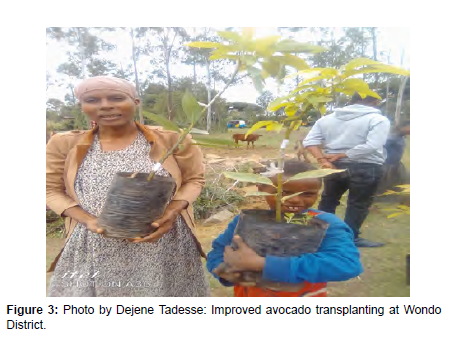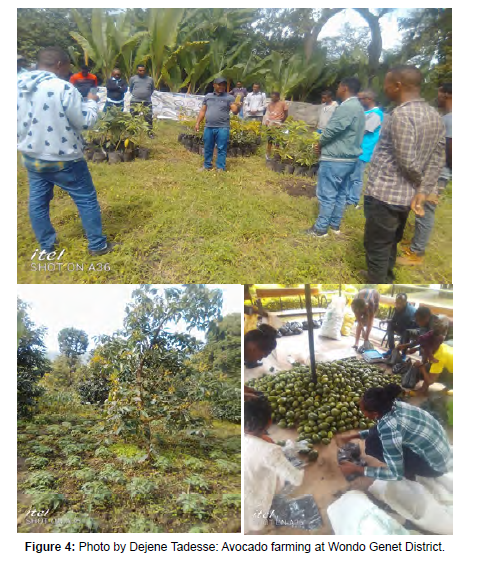Establishment of Improved Avocado Farming Villages at Wondo and Wondo Genet Districts, Southern Ethiopia
Received: 02-Oct-2023 / Manuscript No. acst-23-115256 / Editor assigned: 05-Oct-2023 / PreQC No. acst-23-115256 / Reviewed: 19-Oct-2023 / QC No. acst-23-115256 / Revised: 23-Oct-2023 / Manuscript No. acst-23-115256 / Published Date: 30-Oct-2023
Abstract
Avocado is one of the most economically important climacteric fruits in the world. Ethiopia is among the avocado producing sub-Saharan countries because of the suitable agro-ecologies of the country. In order to improve the avocado production and productivity in the country, Ethiopian Institute of Agricultural Research (EIAR) played great role in avocado variety development and linkage to the producers providing technical support as well as initial avocado technologies. However, avocado production largely dominated by the no-grafted (improved) avocado varieties. Hence, establishment of the grafted avocado farming villages at both Wondo Genet and Wondo districts was conducted to demonstrate and enhance better avocado production and quality through addressing improved avocado seedlings and technical support to farmers. Producers trained about avocado seedling preparation, grafting, transplanting planting, and on-farm tree management practices. Availabilities of grafted (improved) avocado fruits on local markets in both districts and the nearby areas enriched. Female participation in avocado farming and value addition enhanced. However, for comprehensive avocado production and productivity, limitations of the avocado value chain in the study areas should be solved
Keywords
Avocado; Grafting; Scion, Value addition
Introduction
Avocado (Persea americana Miller) is one of the important subtropical/tropical fruit from Lauraceae family (Amare et al.; 2019, Arsi et al., 2021). It is native to Central American and West India and botanically classified in to three groups namely Guatemalan avocado (warm subtropical), West Indian race (the tropical lowland), and Mexican race (cool subtropical) (Morton, 1987; Galindo-Tovar et al., 2007). Special attention given and production strategies developed in many countries to produce quality avocados for food and nutrition security, and income generation, industrial, social, and environmental benefits. Mexico is the leading avocado producer country in the world and recently the production widely increased globally [1].
Ethiopia is being considered as one of the avocado producing countries in sub-Saharan Africa (Biazin et al., 2018). Avocado was first introduced to Ethiopia in 1938 by private orchardists in Hirna and Wondogenet and gradually distributed to other areas where the crop adapted to different agro-ecologies (Edossa, 1997). However, the production of avocado is based on non-grafted avocado trees and is mainly by small-scale farmers for domestic demand. Thanks to Melkasa Agricultural Research Center (MARC), the national coordinator of the research and development of avocado, improved varieties such as Hass, Fuerte, Pinkerton, Bacon, Ettinger, and Nabal have been introduced, evaluated and registered in the country as varieties. Wondo Genet Agricultural Research Center (WGARC) linked the research works with MARC and took the introduced avocado varieties for further evaluation works. As the grafted (improved) varieties showed better yield and growth performances at Wondo Genet Agricultural Research Center, together with the extension wing of the research team promoted to avocado varieties to neighboring farmers. Many avocado seedlings were prepared and distributed to volunteer farmers year to year. However, success of the distributed improved avocado varieties looked for further strategy due to limited knowledge of improved avocados trees management practices. Hence, a new approach called avocado farming village development was initiated to support growers technically in improved avocado production for local and export market. Therefore, the current work was done to develop avocado farming villages for better avocado production and quality through addressing improved avocado seedlings and technical support to farmers at Wondo and Wondogenet districts [2].
Methodology
Site selection
Suitable agro-ecologies were selected in collaboration with districts agricultural offices such as Wondo Genet district (from Sidama Regional State) and Wondo district (from Oromia Regional State) during 2013 cropping season. Both sites (districts) were selected because of the presence of volunteer avocado producers, local markets for non-grafted avocados, suitable agro-ecology, and irrigation accesses. The main crops/plants for production in the selected districts include coffee, khat, sugarcane, local avocado tree, common bean, maize and enset. Haruma, and Soyema Kebeles from Wondo Genet district of Sidama region and Gotu-Onoma Kebele from Wondo district of West Arsi zone, Oromia region were selected for the establishment of avocado farm village [3].
Awareness creation
It was done repetitively for district experts and the farmers’ communities at Wondo Genet Agricultural Research Center. The experts and farmers invited to consider the differences among the non-grafted and grafted (improved) avocado at nursery and field conditions. Farmers largely interested for the production of grafted (improved) avocados.
Farmer selection
It was done by considering land availability, irrigation facilities, quality of farm land handling, commitments to due according to the instructions given by experts and researchers. A village assumed to contains 30-40 farmers with the involvement of female households [4].
Grafted avocado seedlings preparation
It was done by considering the number of farmers and land area for planting at Wondo Genet Agricultural Research Center`s nursery site. Health avocado seeds were used for the rootstock seedling preparation. The seedlings were grafted using improved avocados scions (Hass, Fuerte, Pinkerton, Bacon, Ettinger, and Nabal varieties) and proper seedling management practices such as watering, weeding and removing unwanted side growth were done accordingly. Polyethylene bag was used for filling a mixture of forest soil, top soil, and sand (Figures 1 and 2) [5].
Avocado farming village establishment
Assuming that a village encompasses 30-40 farmers there were
two improved avocados farming villages at Wondo Genet district and one village at Wondo district. Each farmer considered in a village
for farming village creation prepared 60-80 holes for planting the
improved (grafted) avocado seedlings using 6m*6m spacing. Before
transplanting the seedlings to the target village, appropriateness of the
farming sites were evaluated by research team of the center together
with respective experts from the districts. Upon approval of the site
for planting, seedling were taken to each site and the subsequent
management practices were done by farmers themselves with
minimum supervision. The research team and the district agriculture
office seriously monitored and supported the producers’ avocado farms
after transplanting (Figures 3 and 4).
Results
• Farmers trained on avocado seedling rising and grafting practices
• Grafted avocado varieties (Hass, Fuerte, Pinkerton, Bacon, Ettinger, and Nabal) established well at farmers field (avocado farming villages).
• Farming communities got nutritionally improved avocado fruits for home consumption
• Females participation in avocado farming village development motivated
• Farmers income enhanced due to fruit and scion marketing
• The availability of improved avocado for local market enhanced
• Farmers` land became scion source for avocado grafting work
• Number of government and private avocado nurseries (Youth association avocado nursery) enhanced
• Job opportunity created for daily laborers with respect to avocado nursery, production and marketing works.
Limitations
The avocado farming villages lack appropriate harvesting tools, storage facilities and financial supports. Farmers able to sell both scion as well as avocado fruits, however, avocado tree for scion and also for fruit production did not clearing categorized. Besides, proper market access for export purpose did not established yet [6 ].
Conclusion
Avocado farming village establishment showed positive contributions to farmers and the rest of the communities because of the economic and social contributions. The difference between grafted and non-grafted avocado communicated to farmers and each farmers supported technically and by providing initial grafted avocado varieties. Though there is an improvement, the availability of improved avocado fruit on local market at the study areas is still not adequate. There are few nurseries concomitant with improved (grafted) avocado seedlings preparation and further enhancement is critical. Avocado fruit production for export market purpose is untouched opportunity. Local avocado dominated and there is lack of improved harvesting, handling and storage techniques. Therefore, government and nongovernment organizations should support improved avocado farming, handling, value addition, and marketing for the benefits of producers, traders, consumers, and government as well.
Conflict of Interest
The authors declare that there is no conflict of interest regarding the publication of this paper.
Acknowledgment
We would like to thank Subtropical Fruit Research National Program of the Ethiopian Institute of Agricultural Research (EIAR)- Melkasa Agricultural Research Center for financing the work and Wondo Genet Agricultural Research Centre (WGARC) for providing necessary facilities such financial, transport, accommodating trainings during the activities we did. Our acknowledgments also goes to the WGARC`s extension and communication department researcher and technical assistants.
References
- Amare M, Mariara J, Oostendorp R, Pradhan M (2019) The impact of smallholder farmers’ participation in avocado export markets on the labor market, farm yields, sales prices, and incomes in Kenya. Land Use Policy 88: 104168.
- Arsi AA, Fatimah N, Luthfi A, Tohari A, AyuSaputri RW, et al. (2021) From Longan to Avocado: Economic Strategy of Farmers in Agricultural Business in Bandungan District Central Java. In 6th International Conference on Education & Social Sciences 21: 17-20 Atlantis Press.
- Birhanu Biazin B, Haileslassie A, Zewdie T, Mekasha Y, Gebremedhin B, et al (2018) Smallholders’ avocado production systems and tree productivity in the southern highlands of Ethiopia. Agroforest Syst 92: 127-137.
- Edossa E (1997) Selection of Avocado (Persea americana M.) for Collection of Desirable Fruit Characteristics yield at Jimma Proceeding of the 18th Annual Conference of the crope science of Ethiopia. Feb26-27, Addis Ababa, Ethiopia 26-35.
- Galindo-Tovar, Arzate-Fernández ME, Ogata-Aguilar AM, Landero-Torres N (2007) The avocado (Persea americana, Lauraceae) crop in Mesoamerica: 10,000 years of history. Harvard papers in botany 12: 325-334.
- Morton JF (1987) Fruits of warm climates. JF Morton.
Google Scholar, Crossref , Indexed at
Google Scholar, Crossref , Indexed at
Google Scholar, Crossref , Indexed at
Citation: Banjaw DT, Megersa HG, Lema DT, Abewoy D (2023) Establishmentof Improved Avocado Farming Villages at Wondo and Wondo Genet Districts,Southern Ethiopia. Adv Crop Sci Tech 11: 632.
Copyright: © 2023 Banjaw DT, et al. This is an open-access article distributedunder the terms of the Creative Commons Attribution License, which permitsunrestricted use, distribution, and reproduction in any medium, provided theoriginal author and source are credited.
Share This Article
Recommended Journals
Open Access Journals
Article Usage
- Total views: 1444
- [From(publication date): 0-2023 - Apr 25, 2025]
- Breakdown by view type
- HTML page views: 1193
- PDF downloads: 251




